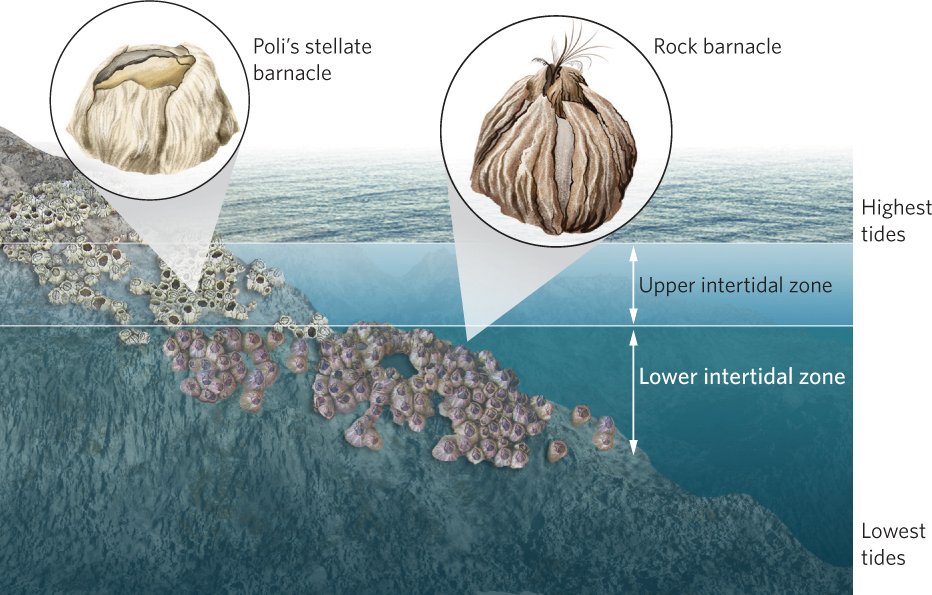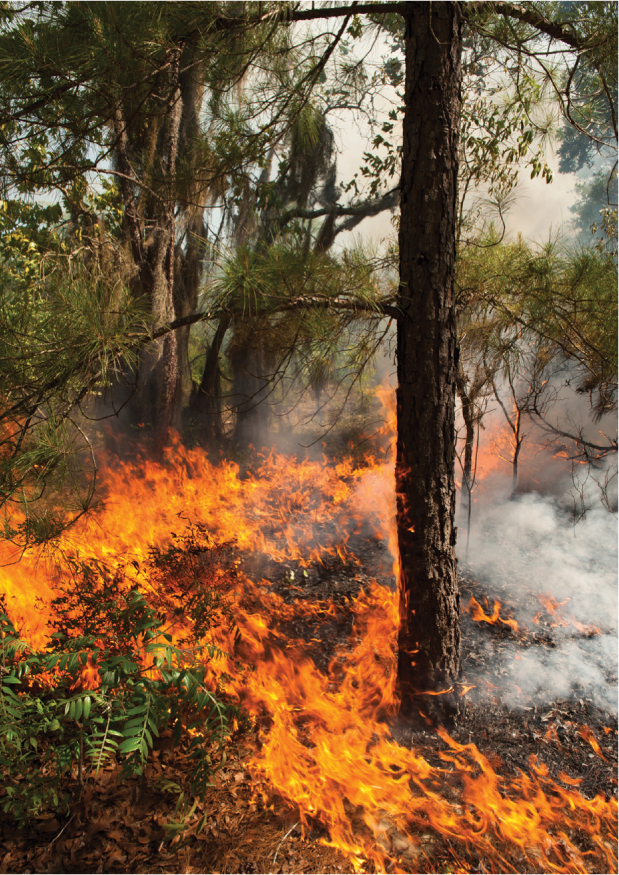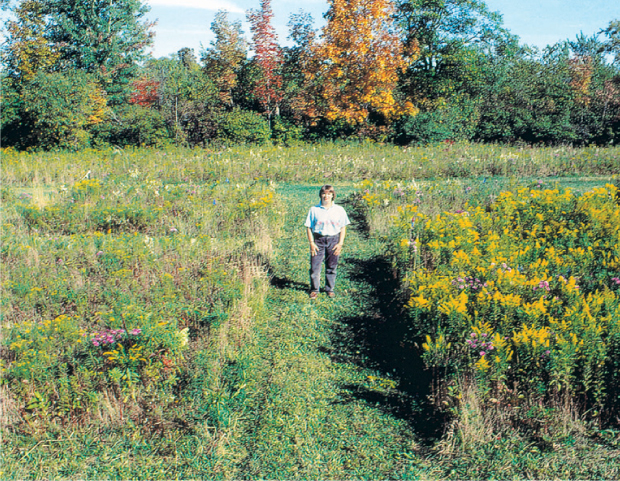The outcome of competition can be altered by abiotic conditions, disturbances, and interactions with other species
We have considered what happens when two species compete for shared resources. However, in nature, competition occurs in the context of variable environmental conditions and in the presence of other types of species interactions, including predation and herbivory. In this section, we will examine how competitive outcomes can be altered by abiotic conditions, disturbance, and interactions with other species.
Abiotic Conditions
The ability to persist when resources are scarce is important to winning in a competitive situation, but it can be overwhelmed by the ability to persist under harsh abiotic conditions. We can see an example of this in a classic study of barnacles, conducted by Joseph Connell in Great Britain. Barnacles begin their lives as larvae that float on the ocean currents and then settle on open, rocky spaces of coastal intertidal zones. They spend the rest of their lives as sessile adults, commonly living in dense groups. They feed on plankton that they filter from the water that washes over them. Plankton are not a limiting resource because the barnacles cannot substantially reduce the vast amount of plankton that exists in coastal waters. However, they are often limited by open spaces on rocks in the intertidal habitat.
Connell observed that the larvae of two barnacle species on the coast of Scotland were distributed broadly along the upper and lower intertidal zones. However, adults were distributed in two separate zones according to species; Poli’s stellate barnacles (Chthamalus stellatus) live in the upper intertidal zone, whereas rock barnacles (Semibalanus balanoides, formerly Balanus balanoides) live in the lower intertidal zone. The two species have only a small overlap in their distributions, as shown in Figure 16.10.

To understand the reason for this distribution, Connell conducted a series of experiments in which he removed one or the other species. He discovered that the stellate barnacles were able to live in the upper intertidal zone because they are resistant to desiccation, which happens during periods of low tide. Though they could live in the lower intertidal zone, competition from the rock barnacle prevented it. The rock barnacle has a rapid growth rate and heavier shell than the stellate barnacle, which allows the rock barnacle to expand in size, pry the stellate barnacle off the rock, and take over the newly opened space. Connell discovered this when he manually removed the rock barnacles from the lower part of the intertidal zone and found that the stellate barnacles quickly moved down and thrived. However, when he removed the stellate barnacle from rocks in the upper intertidal zone, the rock barnacles did not move up because they could not survive the desiccation that occurs in the upper intertidal zone. In short, the distribution of the two species is the result of a trade-off that many species experience—the trade-off between competitive ability and the ability to tolerate a challenging abiotic factor.
380
Disturbances
Competitive interactions among species can also be altered by disturbances. For example, in the southeastern United States more than 36 million ha of forest were once dominated by longleaf pine trees (Pinus palustris) with a very open, grassy understory. Many of the plants that live in this forest depend on fire to persist (Figure 16.11). In fact, some species such as wiregrass (Aristida beyrichiana) can only reproduce after a fire has swept through the forest. Throughout the twentieth century, the natural occurrence of frequent, low-intensity fires was suppressed in much of the longleaf pine forest, which caused the number of other woody plants to increase and outcompete the plants adapted to fire. Fire suppression altered the outcome of plant competition in the forest because it allowed the superior competitors previously removed by fire to persist.

Predation and Herbivory
The outcome of competition can also be altered by the presence of predators and herbivores. We frequently find a trade-off between competitive ability and resistance to predators or herbivores; the most competitive plants are often the most susceptible to herbivores and the most competitive animals are typically the most susceptible to predators. For example, many animals are good competitors because they move a lot in search of food and they have high feeding rates. This activity, though, makes the animals very noticeable to predators and, as a result, animals that are more competitive are more likely to be killed by predators.
Studies of aquatic communities have shown that predators can reverse the outcome of competition. For example, researchers conducted a competition experiment using large, outdoor tanks to simulate ponds. Each pond was supplied with 200 tadpoles of the spadefoot toad (Scaphiopus holbrookii), 300 tadpoles of the spring peeper (Pseudacris crucifer), and 300 tadpoles of the southern toad (Anaxyrus terrestris). After setting up a series of identical tanks, each one was randomly assigned a treatment of 0, 2, 4, or 8 predatory newts (Notophthalmus viridescens).
In the absence of newts, the spadefoot toad’s superior competitive ability was clear. As depicted in Figure 16.12, survival was high for spadefoot toad tadpoles, moderate for southern toad tadpoles, and low for spring peeper tadpoles. Spadefoot toad tadpoles had high survival because they are very active and rapidly consume whatever algae are available. In contrast, southern toad tadpoles are somewhat less active and spring peeper tadpoles are very inactive and therefore grow slowly. When the predatory newts were added, the outcome changed dramatically. As the number of newts increased, the survival of the spadefoot toads dropped precipitously and the survival of the southern toads dropped modestly, which is consistent with the southern toad’s higher activity levels. Compared to the control treatment, the addition of eight newts reduced the survival of spadefoot toads by 75 percent and caused the survival of southern toad tadpoles to decrease by 32 percent. However, the survival of spring peepers increased by 26 percent. Because the newts consumed the superior competitors, the outcome of competition among the three species of tadpoles was reversed.

Herbivores can have a similar effect on competition. For example, several species of goldenrod dominate fallow fields throughout the northeastern United States. These plants can grow more than a meter high and cast shade upon their shorter competitors. A species of beetle (Microrhopala vittata) specializes in consuming the goldenrods. Every 5 to 15 years the beetle population achieves very high densities, known as an insect outbreak, during which the beetles consume large amounts of the goldenrod plants.
381
To determine the impact of the beetles on the plant community, researchers conducted a long-term experiment in which some plots were sprayed with an insecticide to kill the goldenrod-consuming beetles while other plots were left unsprayed. The results were dramatic (Figure 16.13). In the sprayed plots that contained few herbivorous beetles, the goldenrods grew tall and cast shade on the other species of plants. The goldenrods dominated the community because of their superior competitive ability. In the unsprayed plots, the beetles experienced an outbreak midway through the experiment, which significantly reduced the abundance of goldenrod plants. Moreover, the goldenrods that remained were substantially shorter, so they cast less shade on the inferior competitors. With fewer large goldenrods present, the inferior competitors became much more abundant. After 10 years, the researchers confirmed that the beetle was able to reverse the outcome of competition among plants.
